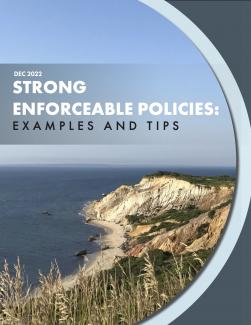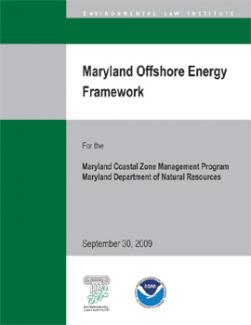Making Law Work Institute guides countries on drafting marine spatial planning legislation with new handbook, implementing ideas
The ocean is significantly altered by human activities, such as fishing, offshore oil and gas development, and plastic use. Future uses such as deep seabed mining have potential to even further affect the marine ecosystem.
As commercial activities in the “blue economy” expand, so too will ocean governance. In order to sustain resources while maintaining long-term growth of economies, countries are increasingly turning to marine spatial planning to manage ocean environments.
MSP allocates the “spatial and temporal distribution of human activities in marine areas,” organizing these different uses to achieve both ecological and economic goals. Although many resources describe how to create a plan, none show how to incorporate MSP into law.
Recognizing this need, ELI, in partnership with Animals | Environment PLLC and under the Blue Prosperity Coalition, published Designing Marine Spatial Planning Legislation for Implementation: A Guide for Legal Drafters in May 2020. The document provides guidance to the busy government lawyer tasked with drafting an MSP law. The guide was followed by a webinar in December and a series of accompanying videos detailing each section of the resource.
The guide draws upon the knowledge and contributions of participants at a 2019 MSP workshop in New Zealand, hosted by ELI in collaboration with the Waitt Institute and IUCN. The four-day event marked the first of a series of workshops by the Blue Prosperity Coalition, a global network of ocean experts working to assist governments in developing MSPs.
Workshop members representing over 16 different countries, primarily from island states in the Pacific region, including Fiji, Niue, Samoa, Tonga, and others, convened to discuss lessons learned and guiding principles for drafting legislation.
Building off these discussions, the guide supports legal drafters from ocean and coastal states where the development of MSP legislation is under consideration. The handbook highlights the essential components and subcomponents of legislation, and explains each feature’s role and significance. It also provides sample text provisions, prepared by the guide’s authors and drawn from existing MSP laws, to address each component. Finally, the guide provides tips for legal drafters. ELI Staff Attorney Sofia O’Connor serves as lead author of the guide.
A follow-up webinar hosted in December was attended by legal drafters, nonprofits, and philanthropy groups. Speakers, including César Toro, head of the Subcommission for the Caribbean and Adjacent Regions of the Intergovernmental Oceanographic Commission of UNESCO, noted the particular significance of planning for island nations that manage ocean territories several hundred times larger than their sovereign land. Maria-Goreti Muavesi, senior environmental legal officer at IUCN Oceania, provided case studies of MSP processes in Pacific Island nations, including Vanuatu, Fiji, and Tonga.
Speakers discussed the importance of understanding a country’s current legal framework to identify gaps and opportunities as well as the need to periodically review plans based on new scientific data and other developments.
This guide marks a significant milestone in ELI’s long-term cooperation with the Waitt Institute on the implementation of MSP, which has included legal assessments in Bermuda, Montserrat, Curacao, and Barbuda. Over more than a decade, ELI has developed a number of publications on MSP and coastal zone management for the Caribbean region, the Pacific, and the United States.
Legal ed course still helping new professionals, but virtually
The 29th Annual Eastern Boot Camp on Environmental Law, ELI’s signature legal education course for environmental professionals, was offered virtually last November. For more than thirty years now, the Eastern Boot Camp has educated new and experienced lawyers, consultants, government officials, and nonprofit and advocacy professionals on the substance and practice of environmental law. The intensive course provides about 20 hours of continuing legal education credits. ELI also offers the Western Boot Camp on Environmental Law, a similar course held on the left coast each spring.
Efforts were of course made to accommodate the unique challenges of hosting a live course online to ensure an optimal experience for both faculty and participants. The program was spread over three consecutive Thursdays, and incorporated more frequent breaks and multiple virtual networking receptions. Brenda Mallory, nominated to be chair of the White House Council on Environmental Quality and an ELI board member, gave opening remarks at the first networking reception, describing her career and trajectory in environmental law. The second networking reception featured Ruth Ann Castro, senior environmental health and safety counsel at Google and ELI board member.
The Eastern Boot Camp holds a reputation as an effective course for preparing professionals beginning or seeking a refresher in the area of environmental law, due in part to its outstanding faculty. Instructors for this year’s National Environmental Policy Act session included leading NEPA experts such as Edward Boling, former associate director at the Council on Environmental Quality, as well as Stacey Bosshardt, former assistant section chief and senior trial attorney in the Justice Department’s Environment and Natural Resources Division.
This year, the timing of the session on environmental justice was extended to reflect growing interest and the need for additional content. Other notable highlights include successful efforts to achieve gender parity within the faculty and participants, and to reflect the diversity of the environmental profession. In the end, the course saw record attendance in its virtual format.
New initiative aims to encourage sustainable growth of high seas
Advances in technology have opened up new possibilities for commercial activities in previously inaccessible areas of the high seas — including shipping, wind and energy development, and marine mining. As a result, concern is growing that these areas beyond national jurisdiction will experience rapid industrialization. The concept of blue growth refers to the expansion of maritime industries and the need to ensure that this new development is conducted in an environmentally sustainable manner.
One way to achieve blue growth is to establish regulatory procedures for ocean industries in the high seas. The Institute’s Blue Growth Law and Governance Initiative, led by ELI Visiting Scholar Patience Whitten and supported by the Leaves of Grass Foundation, was created in August to address these emerging issues and play a leading role in the global discussion on the development of the marine economy.
Whitten, a veteran federal regulator with over twenty years of experience at agencies including EPA and the National Oceanic and Atmospheric Administration, leverages her expertise in environmental impact analyses for large-scale industrial projects and her training in international finance to engage in discussions surrounding blue growth.
In the near term, the initiative will participate in negotiations to develop legal requirements for environmental impact assessments in areas beyond national jurisdiction, part of a larger UN effort known as the BBNJ process. The initiative will also provide input on the next stage of negotiations, when UN members will decide how to operationalize these procedures.
Another area of interest is financing for ocean projects. Recognizing a growing portfolio of economic mechanisms that incorporate social and environmental objectives, the initiative hopes to explore how sustainable financing for high seas projects can influence the environmental outcomes of blue growth.
On a broader level, the initiative seeks to engage both regulators and the regulated community in discussions around sustainable growth. The program intends to not only analyze best practices and contribute to policy outcomes, but also address specific regulatory challenges from the ocean industry community and reflect common interests among a diverse range of stakeholders.
ELI in Action EJ clerkship will support diversity in law profession
In November, ELI and Howard University School of Law announced the formation of the Environmental Justice Clerkship at ELI, a new program designed to train, mentor, and ultimately retain more students of color in environmental law while advancing environmental justice efforts.
Each semester and summer, one Howard law student will work closely with ELI experts on a variety of projects with an emphasis on environmental justice. These may include researching and drafting model bills, assisting overburdened communities with sustainable development planning, and writing reports to support community-driven environmental justice goals. With the support of the True Costs Initiative, each clerk will receive a stipend to ensure that socioeconomic background does not limit the clerkship’s reach.
❧
A considerable number of dry cleaners in the United States use a chemical called perchloroethylene (perc or PCE). PCE releases pose a potential health risk for children and staff at nearby child care facilities. An ELI report titled Federal, State, and Local Policies Addressing Chemical Emissions from Dry Cleaners: Opportunities for Reducing Exposure at Child Care Facilities, released last July, describes some of the laws and regulations that have been established to address this ongoing public health issue. The report discusses air quality regulations, land use and zoning ordinances, and child care licensing regulations. The text supports decisionmakers in developing policies to reduce environmental exposures related to dry cleaners.
❧
Environmental racism refers to the institutional laws and policies that create and perpetuate disproportionate impacts of environmental hazards in marginalized communities. An ELI webinar held in November convened environmental justice experts to discuss opportunities for dismantling environmentally racist practices.
Speaker Carlton Waterhouse, professor of law at Howard University and an ELI Board member, emphasized that white supremacy and racial discrimination are the roots of environmental racial disparities.
Vernice Miller-Travis, executive vice president of Metropolitan Group, highlighted the importance of using both civil rights law and environmental law to guide environmental justice policies and decisionmaking.
Jason Travis Hauter, partner at Akin Gump Strauss Hauer & Feld LLP, described strategies used by American Indian and Alaska Native tribes to address environmental racism. On opportunities for moving forward, Jacqui Patterson, director of the Environmental and Climate Justice Program at the NAACP, emphasized that solutions to environmental racism need to address multiple facets of discrimination, including sexism, ableism, and other forms of oppression.
❧
The Climate Judiciary Project, led in collaboration with the American Association for the Advancement of Science and the Federal Judicial Center, educates judges on the science underpinning arguments in climate cases. Having completed its first year of pilot seminars, the project will now focus on developing an online curriculum that provides recorded lectures and background information on climate science and its application to legal cases.
The curriculum will be composed of 14 different modules prepared by top-tier climate scholars and law experts. An advisory committee of scientists, judges, and legal scholars will provide input on the development of the curriculum. In addition, the project aims to hold a series of live seminars with the judicial community, continuing to expand its efforts to engage judges in discussions around the application of climate science in the law.
❧
In 2019, ELI hosted the inaugural GreenTech Conference in Seattle, convening technology companies, policymakers, young innovators, NGOs, and academia to discuss the future of environmental protection in an era of rapid advances in technology.
This past year, the Institute launched a free, virtual GreenTech webinar series. The first installment, “Digital Solutions to Climate and Water Challenges,” took place in November to discuss how digitizing energy and water services can help reduce the climate and water footprint of sectors like transportation and manufacturing.
Future webinars will explore the environmental applications and implications of artificial intelligence and how tech can support environmental justice and renewable technology.

